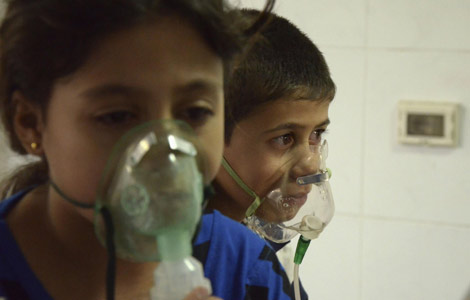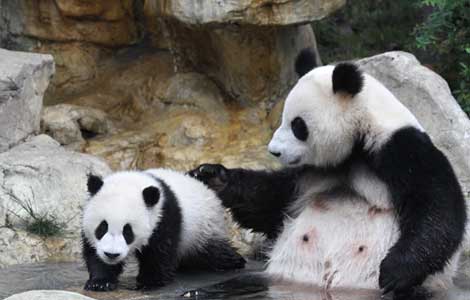
|
Chinese toy makers have to use more environmentally-friendly materials and build brands to cope with the new round of trade regulations from the European Union. Siwei / For China Daily |
Tougher game for chinese producers forced to play by Europe's new safety rules
An updated European Union safety regulation on toys will put pressure on Chinese manufacturers and affect an already weakening European market, but it could also provide an opportunity to upgrade the toy industry in China.
The new toy safety directive, adopted by the European Parliament and the Council of the European Union in 2009, took full effect on July 20, with strict rules designed to improve the chemical, physical and mechanical properties of toy products.
"The implementation of the new directive will pose a huge challenge for Chinese toy manufacturers that export to Europe, as it sets a much stricter threshold for entry to the market," says Xiong Xiaokun, a researcher on light industry at China Investment Consulting Co's industry research center.
In Hangzhou, the capital of East China's Zhejiang province, up to 80 percent of products from about 20 toy companies failed to meet the new technical requirements, according to a survey by local industrial and commercial authorities.
China is the world's biggest toy producer and exporter, with a two-thirds share of the international market. It exported toys worth $11.45 billion (8.53 billion euros) in 2012, including $2.6 billion to the EU, making the EU China's second-largest market for toys, according to the General Administration of Customs.
The new directive includes several new articles on toys' mechanical and electrical performance and chemical and hygiene requirements. In particular, it sets stricter standards on the content of some chemical elements and bans many others, such as N-nitrosamine.
For example, 25 micrograms of arsenic, a poisonous substance that exists widely in nature but can cause cancer and damage the nervous system, were allowed in every gram of toy materials under previous regulation. The new directive restricts the arsenic content to 0.9 micrograms per gram.
"The new directive greatly increases the technical threshold for toy exports to the EU and will definitely drive up the cost of manufacturing toys," says Michael Liu, a toy quality expert with Intertek, one of the world's largest quality and safety solutions providers.
"For manufacturers, the real challenge facing them now is to ensure the purchasing of environmentally friendly materials."
Chen Huandong, who runs a small toy factory in the Chenghai district of Shantou, a major Chinese toy-manufacturing base in South China, says the stricter rules have put great pressure on local toy makers in purchasing new materials and increasing testing procedures.
"We have already been required to use environmentally friendly materials since early this year. It costs us more to buy such materials," Chen says.
Production costs have increased by about 15 percent this year, he adds.
"On top of that, the test costs have increased by 50 percent, making it hard to make profits."
Chen says the company's business has not been largely affected in the past month as all overseas orders had been filled before the new EU rules took effect.
"We have been prepared for the new rules since early this year, and now we are busy making products to ship overseas before the Christmas holidays."
To help enterprises better cope with the new directive, the General Administration of Quality Supervision, Inspection and Quarantine has offered 68 training sessions to more than 2,400 toy makers across China.
The administration has also requested institutes to intensify research on chemical testing and to formulate methods to quickly test for major heavy metals in toys.
Using more environmentally friendly materials means the cost for toy manufacturers will increase by a large margin, according to Jiang Xiaoliang, of the quality inspection and quarantine bureau for Jiangmen in Guangdong province.
To cope with the possible surge in cost, "toy manufacturers should also find alternate materials or upgrade their designs for toys", he says.
Liu Yanfang, secretary-general of Shenzhen Toys Industry Association, says the new regulation will put more pressure on China's exports, which have performed weakly in the first half of the year.
According to the customs authority, China's toy exports registered an increase of only 5.8 percent in 2012, 1.6 percentage points lower than a year earlier, due to increased quality requirements, rising production costs and weak demand in overseas markets.
The new regulations will bring more challenges for large producers, which are building their brands in overseas markets.
"Toy manufacturers should adapt to the changing overseas market, which has introduced a series of technical standards for Chinese toy products," Liu says. "In the long term, companies who attach more importance to self-innovation and building brands will find customers in Europe."
Michael Liu of Intertek, who is also a member of China's National Technical Committee of Standardization for Toys, says the new directive provides an opportunity for domestic enterprises to upgrade industrially.
"If large Chinese toy enterprises seize the opportunity, the new standard will increase the competitiveness of Chinese toy enterprises, help them increase market share and rely less on low prices for competition in the international market," he says.
Industry insiders called on Chinese toy manufacturers to pay more attention to emerging markets to sustain business growth, given that demand in the traditional markets of the United States and Europe is weakening and more technical requirements are expected in the future.
Lin Wei, general manager of Big Tree Toys in Shantou, Guangdong province, said the company has attached increasing significance to domestic and emerging overseas markets.
"Demand in the major markets in the US and Europe has dropped significantly in the past few years, but new demand from the domestic and South American markets has increased," Lin says.
"We will not give up the major market, but we will also develop sales channels in emerging markets."
Liu Yanfang of Shenzhen Toys Industry Association said local companies have been preparing for the new technical requirements for the past few years.
"Many of them already use environmentally friendly materials and have implemented stricter testing measures," Liu says.
"The toy safety rules, which have been stricter since 2010, will help upgrade the industry. Manufacturers in the long term will benefit from the rules as their products will be better placed to find customers in the overseas market."
The technical regulations will bring about more challenges for large producers that are building brands in overseas markets, he adds.
However, in return, such companies will benefit from the European market if their products match up to standards and trends.
Wang Xiaodong in Beijing contributed to the story.
qiuquanlin@chinadaily.com.cn
(China Daily Africa Weekly 08/23/2013 page22)








